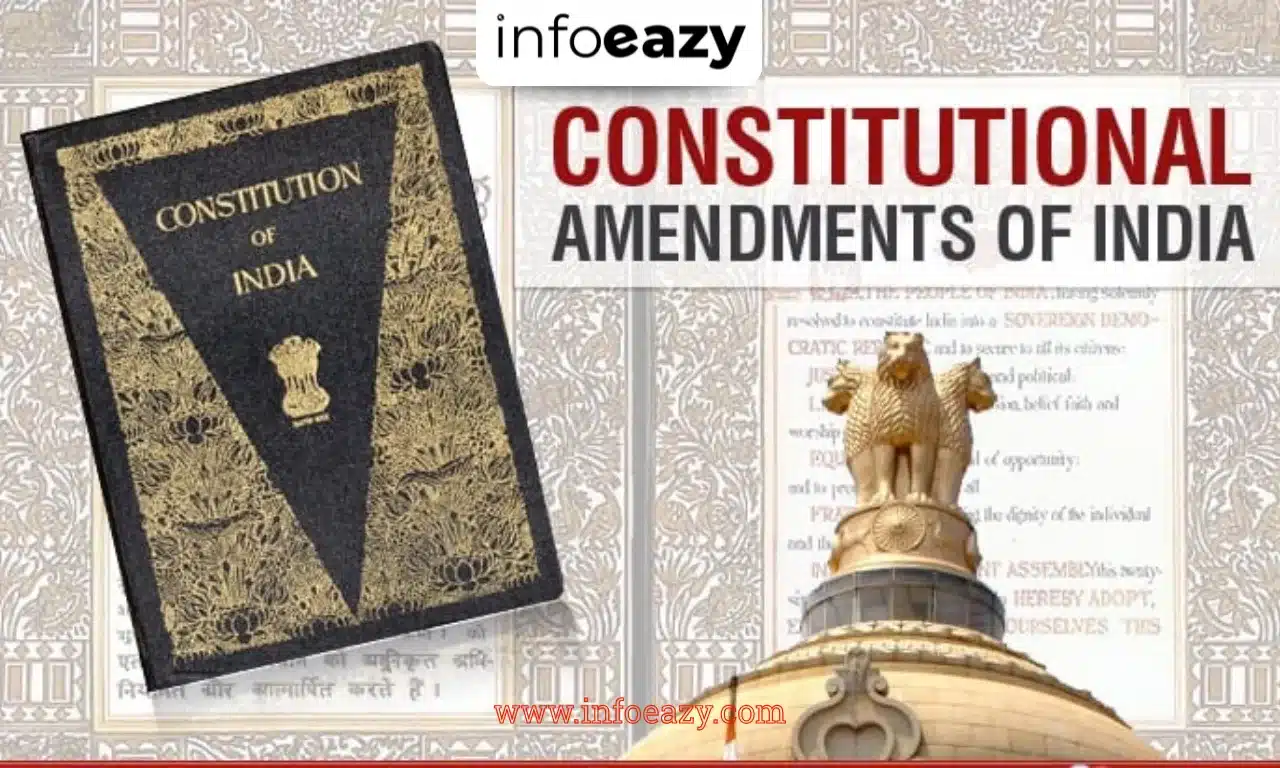The Constitution of India is a living document that has been amended from time to time to meet the needs of the country. Since its adoption in 1950, the Constitution has undergone various amendments to reflect social, political, and economic developments. These amendments are crucial for maintaining the spirit of democracy, federalism, and justice. This article covers the most important amendments with key facts, useful for SSC, Railways, UPSC, and other exams.
The Constitution of India
The Indian Constitution was adopted on 26 January 1950. It is the longest written constitution in the world. As society evolves, so must its laws. To meet these changing needs, Article 368 empowers the Parliament to amend the Constitution. Constitutional amendments help maintain a balance between flexibility and rigidity in governance. So far, 105 amendments have been made. These amendments help protect citizens’ rights, strengthen democracy, and adjust laws to modern requirements.
What is a Constitutional Amendment?
A constitutional amendment refers to an official change or addition made to the Constitution by the Parliament. These amendments are essential to improve governance, uphold rights, and introduce new reforms. For example, the 86th Amendment made education a Fundamental Right. Such amendments can be additions, deletions, or revisions of provisions. Without this mechanism, the Constitution would become outdated. Changes are made while maintaining the basic structure, as established by the Supreme Court in the Kesavananda Bharati case (1973).
Types of Constitutional Amendments
Under Article 368, amendments can be passed using one of three procedures based on the nature of the change. Each type has its own level of difficulty and requirement. Knowing the type helps in understanding which laws need wider approval.
| Type of Amendment | Approval Needed | Examples |
| Simple Majority | Majority in one House | Reorganization of states (e.g. Andhra Pradesh Reorganisation Act, 2014) |
| Special Majority | 2/3 members present and voting in both Houses | Fundamental Rights changes |
| Special Majority + Half of State Legislatures | Special Majority + 50% states’ approval | Changes to federal structure like Election Commission |
Key Constitutional Amendments of India
Here is a list of the most important amendments. These are commonly asked in competitive exams and should be remembered with year and key changes.
| Amendment | Year | Key Feature | Focus |
| 1st | 1951 | Added 9th Schedule, reasonable restrictions on freedom of speech | Landmark in land reform cases |
| 42nd | 1976 | Known as Mini Constitution, added Socialist, Secular in Preamble | Strengthened central powers |
| 44th | 1978 | Right to Property removed as Fundamental Right | Reversed Emergency effects |
| 61st | 1989 | Reduced voting age from 21 to 18 years | Democratic participation boost |
| 73rd | 1992 | Panchayati Raj made constitutional | Grassroots governance |
| 74th | 1992 | Constitutional status to municipalities | Urban development focus |
| 86th | 2002 | Free education for children (6–14 years) | Strengthened Article 21A |
| 101st | 2016 | Introduced GST | One Nation, One Tax |
| 103rd | 2019 | 10% EWS Reservation | Equity in jobs and education |
| 105th | 2021 | Gave states power to identify SEBCs | Strengthened federalism |
42nd Amendment Act, 1976 (Mini Constitution)
The 42nd Amendment, passed during the Emergency in 1976, is the most comprehensive amendment in Indian history. It gave immense powers to the Central Government, curtailed the power of the judiciary, and gave primacy to Directive Principles over Fundamental Rights. It added the words “Socialist”, “Secular”, and “Integrity” to the Preamble. It also extended the duration of Lok Sabha and State Assemblies from 5 to 6 years. This amendment is often called the Mini Constitution for its sweeping changes.
Key Changes under 42nd Amendment:
- Added Fundamental Duties (Article 51A)
- Made President bound by the advice of the Council of Ministers
- Strengthened Directive Principles of State Policy
44th Amendment Act, 1978
Passed after the Emergency, the 44th Amendment aimed to restore democratic values and remove the excessive powers introduced by the 42nd Amendment. It made the Right to Property a legal right instead of a Fundamental Right. It also restricted the President’s power to declare Emergency. The amendment ensured that Fundamental Rights could not be easily suspended, protecting citizens from misuse of power.
Key Features of 44th Amendment:
- Added Article 300A to make Right to Property a legal right
- Restored freedom of press and speech
- Emergency can be proclaimed only after written recommendation of the Cabinet
61st Amendment Act, 1989
This amendment played a crucial role in encouraging youth participation in the electoral process. It reduced the minimum voting age from 21 to 18 years under Article 326. It enabled over five crore young Indians to become voters for the first time. This amendment strengthened democracy and gave young people a voice in shaping the nation.
Impact of 61st Amendment:
- Expanded electoral base significantly
- First applied in 1991 Lok Sabha Elections
- Empowered youth in democratic processes
73rd and 74th Amendments, 1992
These two amendments introduced grassroots democracy in India by giving constitutional status to Panchayati Raj Institutions and Municipalities. The 73rd Amendment added Part IX and the 74th added Part IXA to the Constitution. These changes ensured direct elections, reservations for women, and three-tier governance in rural and urban areas.
| Feature | 73rd Amendment (Panchayats) | 74th Amendment (Municipalities) |
| Level | Rural | Urban |
| Elections | Direct every 5 years | Direct every 5 years |
| Reservation | SC/ST/Women (33%) | SC/ST/Women (33%) |
| Part Added | IX | IXA |
| Schedules | 11th | 12th |
86th Amendment Act, 2002
The 86th Amendment made free and compulsory education for children aged 6 to 14 years a Fundamental Right under Article 21A. It also added a new Fundamental Duty (Article 51A(k)) for parents to send their children to school. This amendment laid the foundation for the Right to Education Act (RTE), 2009. It marked a step forward in achieving universal elementary education.
Highlights of 86th Amendment:
- Added Article 21A
- Introduced 11th Fundamental Duty
- Made education a justiciable right
101st Amendment Act, 2016
This amendment introduced the Goods and Services Tax (GST), which replaced multiple indirect taxes like VAT, Excise, and Service Tax. It added Article 246A and established the GST Council to ensure uniformity across the country. GST came into effect from 1 July 2017 and brought in the concept of One Nation, One Tax. It streamlined the tax structure and improved ease of doing business.
Important GST Features via 101st Amendment:
- Introduced dual GST model (CGST + SGST)
- Abolished multiple central and state taxes
- Created GST Council (Article 279A)
Also Check: Anglo Sikh Wars in India, Battles, Treaty, Impact
103rd Amendment Act, 2019
This amendment provided 10% reservation in jobs and education to Economically Weaker Sections (EWS) of the general category. It amended Articles 15 and 16 to allow this reservation. This amendment is significant as it introduced economic criteria in reservations for the first time without affecting existing SC, ST, and OBC quotas.
Facts about 103rd Amendment:
- Implemented EWS reservation in January 2019
- Does not affect 49.5% existing reservation cap
- For families with annual income less than ₹8 lakh
105th Amendment Act, 2021
The 105th Amendment restored the power of states to identify Socially and Educationally Backward Classes (SEBCs). After the Supreme Court’s Maratha reservation verdict, this amendment clarified that states have the power to maintain their SEBC lists. It amended Article 342A, strengthening the federal structure of the Constitution.
Key Aspects:
- Reaffirmed state powers
- Applicable to both Central and State OBC lists
- Passed in August 2021
Total Number of Constitutional Amendments
As of July 2025, India has passed 105 Constitutional Amendments. The table below shows an overview:
| Aspects | Features |
| Total Amendments | 105 |
| Recent Amendment | 105th (2021) |
| 1st Amendment | 1951 |
| Most Comprehensive | 42nd Amendment |
Conclusion
Constitutional Amendments are essential to keep Indian democracy dynamic and responsive. From protecting rights to introducing reforms like GST and education for all, amendments shape India’s legal framework. Understanding their significance and key features is important for both citizens and exam aspirants.
Constitutional Amendments FAQs
Q1. How many amendments have been made to the Indian Constitution as of 2025? +
Q2. Which amendment added the term ‘Secular’ to the Preamble? +
Q3. When was the voting age reduced to 18 years in India?+
Q4. Which amendment introduced the GST? +
Q5. What is the purpose of the 103rd Amendment? +
Tags: current affairs Important Amendments of the Constitution of India Notes Railway




